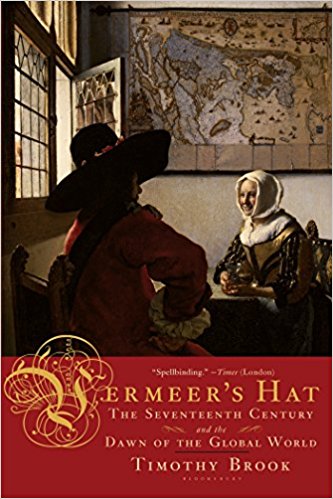You are here
Jeff Ctr Book Grp: Vermeer’s Hat: The Seventeenth Century and the dawn of the Global World
Primary tabs

Location: Jeff Center in the Old Ashland Armory
The following (footnotes and citations removed) is from https://en.wikipedia.org/wiki/Vermeer%27s_Hat:
Brook argues that globalization, which is often taken to be a modern (i.e. late-20th/21st-century) phenomenon, actually had its roots in the 17th century; and he states that it was his intention to surprise his readers with this information, that "people and goods and ideas were moving around the world in ways that their ancestors had no idea was possible." The growth in trade and exploration was facilitated in part by advances in navigation and in shipbuilding technology and also, according to the author, was driven along when European nations such as "England, the Netherlands and France started to fight their way into the trade."
By studying and analyzing the paintings of Johannes Vermeer, beginning with his landscape View of Delft, and examining the scant documents detailing his life, the author builds up a picture of the world in which Vermeer lived; and from this he finds evidence of socioeconomic phenomena and globalization. In the case of the port in Delft in the Netherlands, for example, he finds evidence of the Dutch East India Company's operations. This is often said to be the world's first multinational corporation, which competing traders were forced to join; it had quasi-governmental powers, including the ability to wage war, negotiate treaties, coin money, and establish colonies, and played a powerful and prominent role in trade between the Dutch and Asia, including China.
The painting entitled Officer and Laughing Girl, which is shown on the front cover of the book and to which the title alludes, speaks to Brook of the interest people had in the world, which is reflected in the maps of the world frequently seen on walls in paintings, showing a patriotic pride which went along with the emergence of the Netherlands from Spanish occupation, and the painting is also used to examine trade between Europe and North America. The huge felt hat itself, Brook says, is made of beaver under-fur and the origin of that would be via French traders operating in North America. This being before the discovery of the Northwest Passage, the French had been commissioned to find a route to China, and the beaver fur simply helped them "cover their costs." From here, the narrative goes on to talk of other commodities which were available in abundance and traded in the Americas, such as sugar, tobacco, copper, wood in the 18th century, slaves from Africa, and the metallic artefacts and guns which were given in exchange.
In the painting Girl Reading a Letter at an Open Window, there is a large Chinese porcelain bowl in the foreground (standing on a Turkish carpet), and Brook uses this to introduce the subject of trade with China. Chinese porcelain was just becoming more widely available and featured in many paintings. The porcelain grew very popular in households in Vermeer's time as its price came down and it became affordable to less wealthy families. In sharp contrast to the necessary outward-looking gaze of countries in Europe, the stereotypical view of China was that it had "an adequate resource base for most of its needs, an advanced technology and was not having to look outside of itself for things that it needed." However, Brook maintains that the Chinese did venture out of their country to trade during lengthy periods when they were not prohibited from doing so (due to perceived threats to Chinese authority or to Chinese people), and that the Chinese simply wanted to control the terms of their trade. They did not want traders setting up colonies in their sovereign territory.[2] According to Brook, the Chinese not going out exploring the world did put them at a technological and linguistic disadvantage as they had a very limited world view and lacked experience of the increasingly cosmopolitan world outside their borders. This wasn't so much of a problem in Vermeer's time but was to become more of an issue as Europe's empires grew in the 18th century and 19th centuries.
- Log in to post comments
